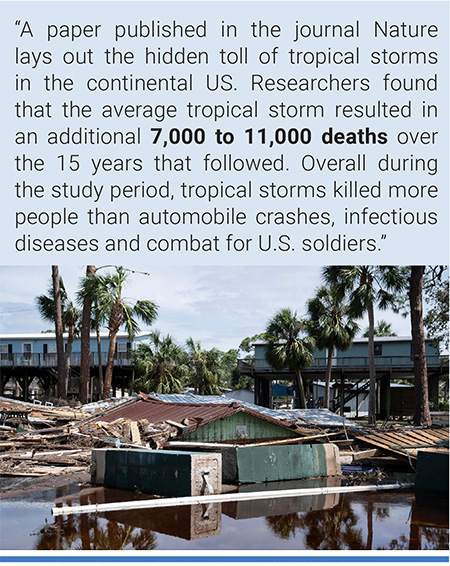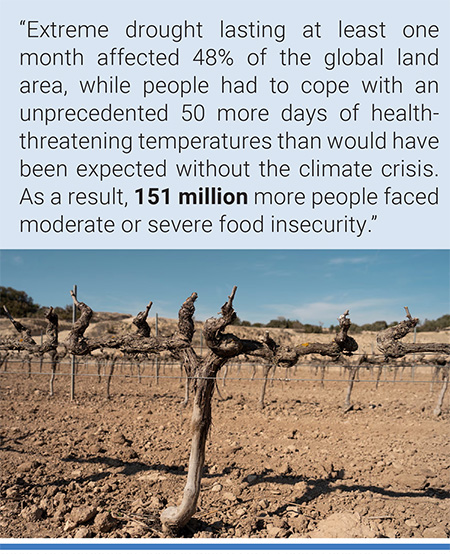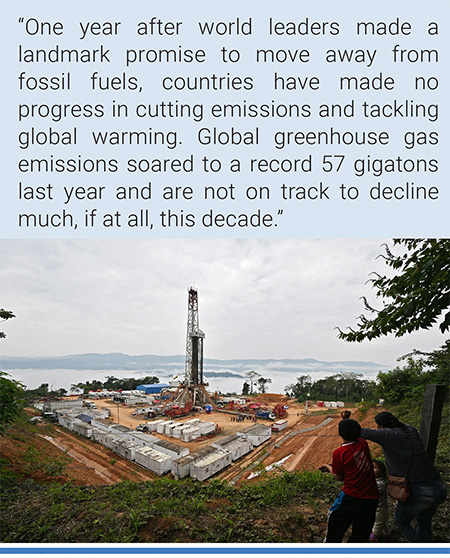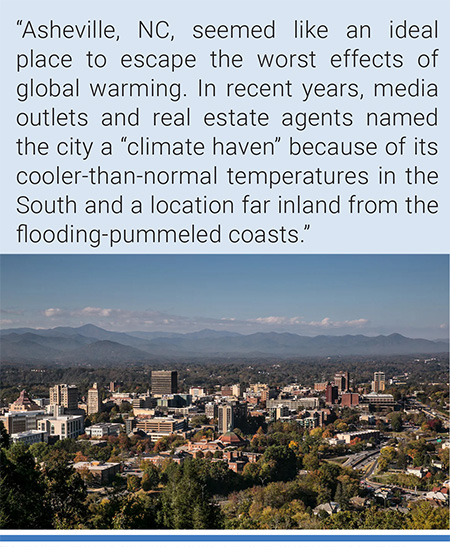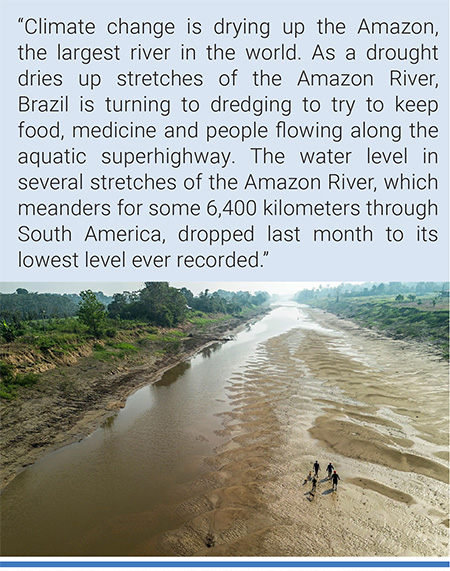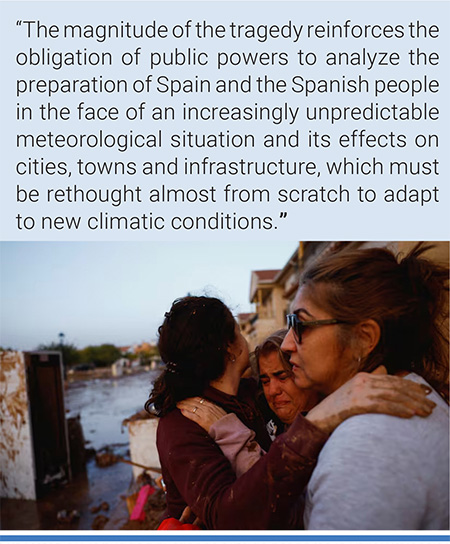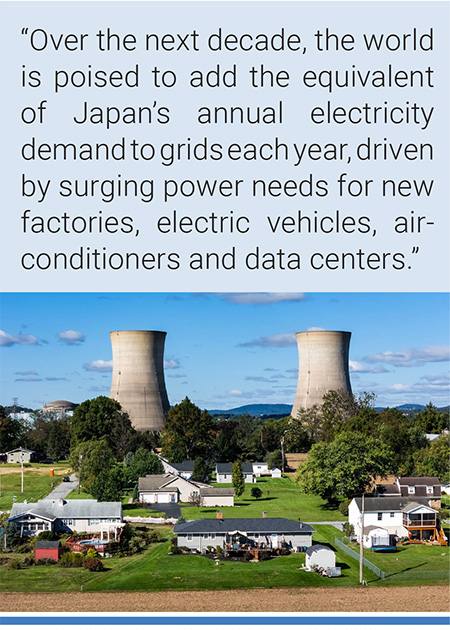Monthly Summaries
Issue 94, October 2024 | "No ‘climate havens’"
[PDF]
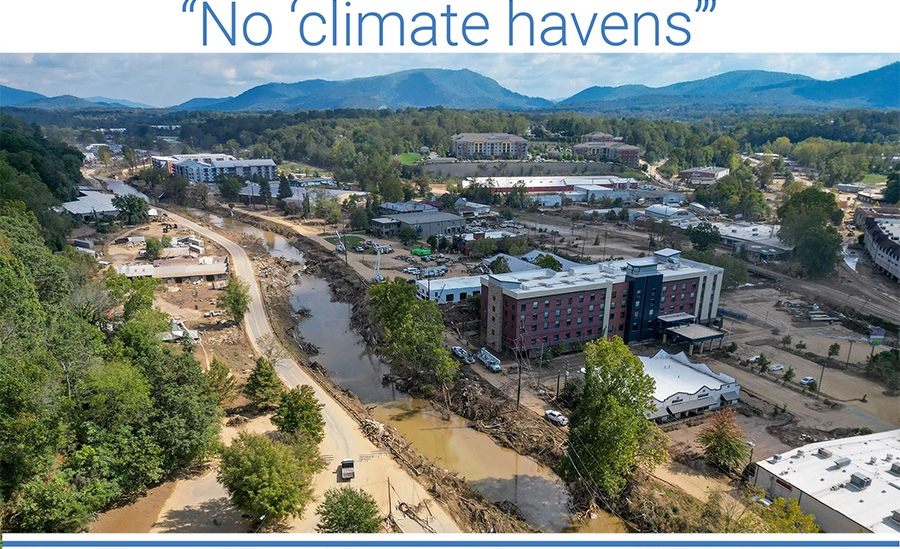
Clean up along the Swannanoa River continues during the aftermath of flooding caused by the remnants of Hurricane Helene in October 2024 in Asheville, NC. Photo: Nathan Fish/USA Today.
October media coverage of climate change or global warming in newspapers around the globe crept up 5% from September 2024. Furthermore, coverage in October 2024 edged 1% higher than October 2023. Figure 1 shows trends in newspaper media coverage at the global scale – organized into seven geographical regions around the world – from January 2004 through October 2024.

Figure 1. Newspaper media coverage of climate change or global warming in print sources in seven different regions around the world, from January 2004 through October 2024.
At the regional level, October 2024 coverage went up in the European Union (EU) (+2%), Asia (+5%), Oceania (+7%), North America (+7%), the Middle East (+17%), and Latin America (+18%) compared to the previous month of September. Meanwhile, coverage decreased in Africa (-5%) (Figure 2 shows these regional trends).

Figure 2. Coverage of climate change or global warming in Asia from January 2004 through October 2024.
Among our country-level monitoring, for example Spanish print coverage increased 29% (Figure 3), and United States (US) print coverage increased 11% while US television coverage went up 33% in October 2024 compared to the previous month of September.

Figure 3. Spanish newspaper coverage of climate change or global warming from January 2000 through October 2024.
Our Media and Climate Change Observatory (MeCCO) team continues to provide three international and seven ongoing regional assessments of trends in coverage, along with 16 country-level appraisals each month. Visit our website for open-source datasets and downloadable visuals.
Damage from Hurricane Helene in Horseshoe Beach, FL. Photo: Nicole Craine/New York Times. |
Regarding October 2024 content of news coverage about climate change, there were several stories with primarily scientific themes. For example, an open access Nature journal article entitled ‘Mortality caused by tropical cyclones in the United States’ by Rachel Young and Solomon Hsiang garnered attention in many outlets. For example, New York Times journalist Lydia DePillis reported, “Over the past week, the official death toll from Hurricane Helene has surpassed 100 as the vortex creeping inland from Florida submerged homes and swept away cars. But the full weight of lost lives will be realized only years from now — and it could number in the thousands. A paper published in the journal Nature on Wednesday lays out the hidden toll of tropical storms in the continental United States. Looking at 501 events from 1930 to 2015, researchers found that the average tropical storm resulted in an additional 7,000 to 11,000 deaths over the 15 years that followed. Overall during the study period, tropical storms killed more people than automobile crashes, infectious diseases and combat for U.S. soldiers. It’s such a big number — especially compared with the 24 direct deaths caused by hurricanes on average, according to federal statistics — that the authors spent years checking the math to make sure they were right. “The scale of these results is dramatically different from what we expected,” said Solomon Hsiang, a professor of global environmental policy at the Doerr School of Sustainability at Stanford University, who conducted the study with Rachel Young, the Ciriacy-Wantrup postdoctoral fellow at the University of California, Berkeley. The pair used a technique that has also provided a more complete understanding of “excess deaths” caused by Covid-19 and heat waves. It works by looking at typical mortality patterns and isolating anomalies that could have been caused only by the variable under study — in this case, a sizable storm… Cumulatively, the study found, storms weigh most on states that are hit repeatedly, like Florida, where Dr. Hsiang and Dr. Young attribute 13 percent of overall deaths to the stormy climate. Individual storms, however, are a heavier blow in states that are hit only occasionally, possibly because their systems and infrastructure are less prepared for it. The threat from hurricanes is expected to increase because of climate change. Although deaths rose throughout the 20th century as the population grew on the Atlantic and Gulf Coasts, Dr. Young and Dr. Hsiang’s data shows an inflection point around 2001, as storms started to become more frequent. For that reason, even though direct deaths from storms have declined over the decades, Dr. Hsiang urged more research into the much greater number of deaths that occur long after the skies have cleared”.
Impact of a drought in Spain in March 2023. Photo: Paola de Grenet/The Guardian. |
In late October, the 2024 report of the Lancet Countdown on health and climate change: facing record-breaking threats from delayed action – with co-authorship from MeCCO team members Lucy McAllister and Olivia Pearman among contributors from around the world – generated significant coverage. For example, Guardian correspondent Anna Bawdin wrote, “Heat-related deaths, food insecurity and the spread of infectious diseases caused by the climate crisis have reached record levels, according to a landmark report. The Lancet Countdown’s ninth report on health and the climate breakdown reveals that people across the world face unprecedented threats to their health from the rapidly changing climate…The report finds that in 2023, extreme drought lasting at least one month affected 48% of the global land area, while people had to cope with an unprecedented 50 more days of health-threatening temperatures than would have been expected without the climate crisis. As a result, 151 million more people faced moderate or severe food insecurity, risking malnutrition and other harm to their health. Heat related deaths among the over-65s rocketed by 167% in 2023, compared with the 1990s. Without the climate crisis, an ageing global population means such deaths would have increased, but only by 65%. High temperatures also led to a record 6% more hours of lost sleep in 2023 than the 1986–2005 average. Poor sleep has a profound negative effect on physical and mental health. Hotter and drier weather saw greater numbers of sand and dust storms, which contributed to a 31% increase in the number of people exposed to dangerously high particulate matter concentrations, while life-threatening diseases such as dengue, malaria and West Nile virus continue to spread into new areas as a result of higher temperatures. But despite this, “governments and companies continue to invest in fossil fuels, resulting in all-time high greenhouse gas emissions and staggering tree loss, reducing the survival chances of people all around the globe”, the authors found. In 2023, global energy-related carbon dioxide emissions reached an all-time high, 1.1% above 2022, and the proportion of fossil fuels in the global energy system increased for the first time in a decade during 2021, reaching 80.3% of all energy”.
A natural gas field in Bolivia Photo: Aizar Raldes/Agence France-Presse. |
United Nations (UN) Emissions Gap Report generated media attention. For example, New York Times journalist Brad Plumer reported, “One year after world leaders made a landmark promise to move away from fossil fuels, countries have essentially made no progress in cutting emissions and tackling global warming, according to a United Nations report issued on Thursday. Global greenhouse gas emissions soared to a record 57 gigatons last year and are not on track to decline much, if at all, this decade, the report found. Collectively, nations have been so slow to curtail their use of oil, gas and coal that it now looks unlikely that countries will be able to limit global warming to the levels they agreed to under the 2015 Paris climate agreement. “Another year passed without action means we’re worse off,” said Anne Olhoff, a climate policy expert based in Denmark and a co-author of the assessment, known as the Emissions Gap Report”.
Next, media portrayals with primarily ecological and meteorological dimensions again drove significant coverage among overall climate change or global warming accounts in October. To begin, hurricane Helene devastation and recovery efforts – with several stories linking to climate change and global warming – in the US earned considerable attention. For example, CNN correspondent Steve Almasy reported, “Hundreds of roads remain closed, hampering efforts to send aid to hard-hit communities. And for those who left before Helene, it’s delayed their returns to check on family, friends and the state of their homes. Some areas are so inaccessible supplies are being delivered by mules and by air. In Weaverville, North Carolina, things are improving for around 5,000 residents, but “they’re still pretty rough,” Mayor Patrick Fitzsimmons told CNN on Wednesday. The mayor was speaking from the grocery store: the only place in town that had working Wi-Fi, he said. Meanwhile, more than 200 people in Buncombe County, North Carolina, remain unaccounted for as of Thursday afternoon, Sheriff Quentin Miller said at a news briefing. “We know these are hard times, but please know we’re coming to get you,” Miller said. “We will not rest until you are secure and you are being cared for.” When asked for clarity on the number of people unaccounted for, county spokesperson Lillian Govus said the number fluctuates rapidly, as search and rescue efforts are ongoing. The county’s register of deeds is knocking on doors to check on community members, Govus said during a news conference. “Once those crews have exhausted every resource they have at their fingertips, that’s when the search and rescue efforts will conclude, and we will have a number to share at that time,” Govus said. Relief efforts across the damaged areas are picking up as linemen restore power and the military and relief groups bring in people and supplies. On Wednesday, President Joe Biden deployed 1,000 troops from Fort Liberty in eastern North Carolina to the ravaged western part of the state. Biden visited North and South Carolina on Wednesday while Vice President Kamala Harris visited Augusta, Georgia, a city still under a curfew and a boil water advisory”. Meanwhile, Washington Post journalists Shannon Osaka and Sarah Kaplan noted, “Asheville, N.C., seemed like an ideal place to escape the worst effects of global warming. In recent years, media outlets and real estate agents named the city a “climate haven” because of its cooler-than-normal temperatures in the South and a location far inland from the flooding-pummeled coasts. Last year, the Asheville Citizen Times reported on worries that the city would become overcrowded from climate-change migration. Then, the flooding came. In some areas of western North Carolina, four to five months of rain fell in less than three days. More than 40 people have died in Buncombe County, where Asheville is the county seat, as homes, businesses, roads and livelihoods were swept away in the rising waters of Hurricane Helene. The floods illuminate two truths about a world transformed by global warming, experts say. It is unlikely that any places will be truly safe from climate change — and even high-elevation, inland areas are vulnerable to drowning in a world where planetary warming is fueling heavier rains. It is a law of physics that, for every degree Celsius increase in temperature, air is able to hold 7 percent more water vapor. This phenomenon increases the moisture available for storms, making individual events wetter than they otherwise would be and increasing the risk of unprecedented rain. The United States and countries around the globe are already experiencing what could lie in store. Last year, areas of Vermont were deluged by devastating rains that would have been exceedingly rare in an unchanged climate. This summer, a town in southern New Mexico was struck by eight floods in four weeks, after wildfires destroyed vegetation and subsequent rain funneled directly into neighborhoods. And just a few weeks ago, floods and heavy rain surged over Central Europe. Although some have called this age the “Pyrocene,” because of growing wildfires, scientists also emphasize the world is heading toward a watery future of surging oceans and worsening floods”.
Asheville, North Carolina. Photo: George Rose/Getty Images. |
Following on hurricane Helene’s late September landfall, hurricane Milton’s early October arrival in the US generated a lot of media hits (with several stories connecting the dots to a changing climate). For example, Associated Press reporter Alexa St. John wrote, “Human-caused climate change intensified deadly Hurricane Milton ‘s rainfall by 20 to 30% and strengthened its winds by about 10%, scientists said in a new flash study. The analysis comes just two weeks after Hurricane Helene devastated the southeastern United States, a storm also fueled by climate change. World Weather Attribution researchers said Friday that without climate change, a hurricane like Milton would make landfall as a weaker Category 2, not considered a “major” storm, instead of a Category 3. WWA’s rapid studies aren’t peer-reviewed but use peer-reviewed methods. The WWA compares a weather event with what might have been expected in a world that hasn’t warmed about 1.3 degree Celsius since pre-industrial times. The team of scientists test the influence of climate change on storms by analyzing weather data and climate models, but in the case of Milton — which followed so shortly after Helene — the researchers used only weather observations data. WWA said despite using different approaches, the results are compatible with studies of other hurricanes in the area that show a similar hurricane intensity increase of between 10 and 50% due to climate change, and about a doubling in likelihood”. For example, The New York Times journalist Ana Ionova wrote: “Climate change is drying up the Amazon, the largest river in the world. As a drought dries up stretches of the Amazon River, Brazil is turning to dredging to try to keep food, medicine and people flowing along the aquatic superhighway. The water level in several stretches of the Amazon River, which meanders for some 6,400 kilometers through South America, dropped last month to its lowest level ever recorded, according to data from the Geological Survey of Brazil. “The crisis has paralyzed the Amazon, a vital water superhighway that serves as virtually the only means of connecting forest communities and moving commerce in some of the most remote stretches of the planet.” La Vanguardia journalist Rosa Tristán noted, “The lowering of the level of the great Amazon channels, to the point of making navigation unviable, has left thousands of communities cut off throughout the basin. The Government of Brazil has decided to dredge, in some places, the Negro River, while in Colombia they are looking for ways to bring humanitarian aid and in Bolivia the situation is causing thousands of people to leave the jungle towards safer places. Increasingly uncontrolled fires, deforestation that does not stop, together with extreme droughts and floods linked to climate change, and from 2023 accentuated by El Niño, are the fundamental factors that according to experts are behind this situation that is putting into effect the survival of numerous Amazonian populations is seriously endangered, while at the same time it threatens a unique biodiversity."
A much-depleted tributary of the Amazon, the Parana do Manaquiri. Photo: Raphael Alves/EPA. |
Meanwhile, devastating flooding in Spain made news around Europe and around the world in October. Dozens of newspaper front pages around the world published photographs of cars piled up by the strong floods while several stories made links between the flooding and global warming or climate change. For an example in Spanish outlets, El País journalist Manuel Planelles wrote, “Hurricanes and torrential rains: the meteorological monsters fueled by human-caused global warming. The planet is experiencing a succession of extreme phenomena, such as the one suffered in recent hours in parts of the Valencian Community and Castilla-La Mancha, which scientific reports often conclude are fueled by climate change”. As a second example, La Vanguardia noted, “To the human losses we must add the material losses, both in infrastructure, especially those used for transport, and in the agricultural sector, which may have lost the harvest of thousands of hectares. The effects of the cold drop have been catastrophic in many ways. And not only in the Valencian Community. Also, although to a much lesser extent, in Albacete, Cuenca, Almería, Málaga, Cádiz… There have always been extreme meteorological phenomena in Spain, capable of completely altering daily life. But it is well known that the climate crisis has exacerbated and increased their destructive power: with more heat in the atmosphere, meteorological phenomena become more violent. What happened in Valencia the day before yesterday reminds us of this once again.” A third example is an editorial in El País that remarked, “The magnitude of the tragedy reinforces the obligation of public powers to analyze the preparation of Spain and the Spanish people in the face of an increasingly unpredictable meteorological situation and its effects on cities, towns and infrastructure, which must be rethought almost from scratch to adapt to new climatic conditions”. As an example of international coverage, BBC journalists Bethany Bell and Frances Mao reported, “At least 158 people have died in Spain's worst flooding disaster in generations as rescuers battle odds to find survivors…Authorities have called the downpours and flooding "unprecedented". Many factors contribute to flooding, but a warming atmosphere caused by climate change makes extreme rainfall more likely. Weather researchers have identified the likely main cause of the intense rainfall as a “gota fria” – a natural weather event that hits Spain in autumn and winter when cold air descends on warmer waters over the Mediterranean. However, the increase in global temperatures had led to the clouds carrying more rain, scientists told the BBC. The world has already warmed by about 1.1C since the industrial era began and temperatures will keep rising unless governments around the world make steep cuts to emissions. “No doubt about it, these explosive downpours were intensified by climate change," said Dr Friederike Otto, from Imperial College London, who leads an international group of scientists who try to understand the role that warming plays in these type of events. The death toll is the worst from floods in Spain since 1973, when at least 150 people were estimated to have died in the southeastern provinces of Granada, Murcia and Almeria”.
Eva Defez, 50, is hugged by friends outside her home in Utriel (Valencia). Photo: Susana Vera/Reuters. |
In October 2024, media representations also contained cultural-themed stories relating to climate change or global warming. For example, every day engagements with energy – supply and demand – as it potentially relates to climate change or global warming fed news accounts in October. To illustrate, New York Times journalist Brad Plumer reported, “Demand for electricity around the world is rising faster than expected, making it harder for countries to slash their emissions and keep global warming in check, the International Energy Agency said…Over the next decade, the world is poised to add the equivalent of Japan’s annual electricity demand to grids each year, driven by surging power needs for new factories, electric vehicles, air-conditioners and data centers, according to the agency’s annual World Energy Outlook, a comprehensive report on global energy trends. In all, the agency now expects global electricity demand to be 6 percent higher in 2035 than it forecast last year. It’s not all dire news for climate change: The report concludes that countries are likely to build enough low-emissions power plants by the end of the decade — primarily solar, wind and nuclear power — to match that rise in demand. Rapid growth in renewable energy should at least prevent global emissions from rising drastically and could cause coal, oil and natural gas use to peak this decade. But to stop global warming, many countries have pledged to reduce their emissions to zero by around midcentury. That goal is slipping out of reach: Countries would need to build low-carbon electricity sources twice as fast as they’re currently doing between now and 2035 to meet their climate targets”.
Last, political and economic-themed media stories about climate change or global warming appeared in many television, radio and newspaper outlets in October. For example, Guardian correspondent Jillian Ambrose reported, “Britain’s only remaining coal power plant at Ratcliffe-on-Soar in Nottinghamshire will generate electricity for the last time on Monday after powering the UK for 57 years. The power plant will come to the end of its life in line with the government’s world-leading policy to phase out coal power which was first signalled almost a decade ago. The closure marks the end of Britain’s 142-year history of coal power use which began when the world’s first coal-fired power station, the Holborn Viaduct power station, began generating electricity in 1882. The shutdown has been hailed by green campaigners as a major achievement for the government in reducing the UK’s carbon emissions, providing international climate leadership, and ensuring a “just transition” for staff in Britain’s coal industry. Michael Shanks, the minister for energy, said: “Today’s closure at Ratcliffe marks the end of an era and coal workers can be rightly proud of their work powering our country for over 140 years. We owe generations a debt of gratitude as a country.” The UK became the first country to set an end date for coal power from 2025 after putting in place increasingly stringent green regulations to reduce the running hours of its coal plants”.
Cooling towers of a shuttered nuclear power plant in Pennsylvania, which will reopen in 2028 to supply power to Microsoft data centers. Photo: Jim Lo Scalzo/EPA. |
Meanwhile, in Mexico the swearing in of President Claudia Sheinbaum (also a contributor to the UN Intergovernmental Panel on Climate Change reports) earned news attention about her approach to climate change. For example, Associated Press correspondents Fabiola Sánchez and Mariana Martínez Barba reported, “Claudia Sheinbaum was sworn in Tuesday as Mexico’s first female president, riding the enthusiasm over her predecessor’s social programs but also facing challenges that include stubbornly high levels of violence. After a smiling Sheinbaum took the oath of office on the floor of Congress, legislators shouted “Presidenta! Presidenta!” using the feminine form of president in Spanish for the first time in over 200 years of Mexico’s history as an independent country. The 62-year-old scientist-turned-politician receives a country with a number of immediate problems, also including a sluggish economy, unfinished building programs, rising debt and the hurricane-battered resort city of Acapulco…At her inauguration, Sheinbaum boosted the free trade agreement with the United States and Canada, saying “we know that economic cooperation strengthens the three nations.” There are areas where Sheinbaum could try to take Mexico in a new direction. For example, she has a Ph.D. in energy engineering and has spoken of the need to address climate change. But on Tuesday, she said she would cap oil production at 1.8 million barrels per day, which would be more than what the troubled state-owned company currently produces. “We are going to promote energy efficiency and the transition toward renewable sources of energy,” she said”. Meanwhile, Washington Post journalists Mary Beth Sheridan, Dino Grandoni and Lorena Ríos noted, “She was an energy engineer, a quiet, driven Mexican academic who’d worked at a major U.S. government lab and investigated some of the toughest problems in climate change. Claudia Sheinbaum was a natural choice when the prestigious U.N. Intergovernmental Panel on Climate Change selected scientists for a landmark report in 2014. It would warn the world was hurtling toward “irreversible” damage from greenhouse gases, and call for urgent action. Sheinbaum’s contributions were “an added value for the team,” said Manfred Fischedick, a professor in Germany who worked on the report. “And — I would like to stress that aspect specifically — she never came across as a politician.” Now, Sheinbaum is about to become Mexico’s president. Her election has given hope to environmentalists and diplomats who’ve despaired as Mexico has gone from a global leader on climate change to a laggard. Yet Sheinbaum has a complicated record. She’s the protégé of outgoing President Andrés Manuel López Obrador, known as AMLO, who sidelined green-energy projects and prioritized tapping petroleum fields. In her recent stint as Mexico City mayor, Sheinbaum loyally defended his policies — even as she introduced electric buses and covered the capital’s massive food market with solar panels”.
Finally, the much-anticipated US election – and the impacts the results have on climate politics and policy – earned coverage that picked up more speed in October. For example, Wall Street Journal correspondents Collin Eaton and Benoît Morenne wrote, “Oil companies are conveying an unlikely message to the GOP and its presidential candidate: Spare President Biden’s signature climate law. At least the parts that benefit the oil industry. In discussions with former President Trump’s campaign and his allies in Congress, oil giants including Exxon Mobil, Phillips and Occidental Petroleum have extolled the benefits of the Inflation Reduction Act. Many in the fossil-fuel industry opposed the law when it passed in 2022 but have come to love provisions that earmark billions of dollars for low-carbon energy projects they are betting on. Some executives in the largely pro-Trump oil industry are worried the former president, if re-elected, would side with conservative lawmakers who want to gut the IRA. They fear losing tax credits vital for their investments in renewable fuel, carbon capture and hydrogen, costly technologies requiring U.S. support to survive their early years”.

Figure 4. Examples of newspaper front pages with climate change stories in October 2024.
Keep hope alive, and contribute to MeCCO’s ongoing work by following this link here to make a donation.
- report prepared by Max Boykoff, Rogelio Fernández-Reyes, Ami Nacu-Schmidt, Jeremiah Osborne-Gowey and Olivia Pearman

